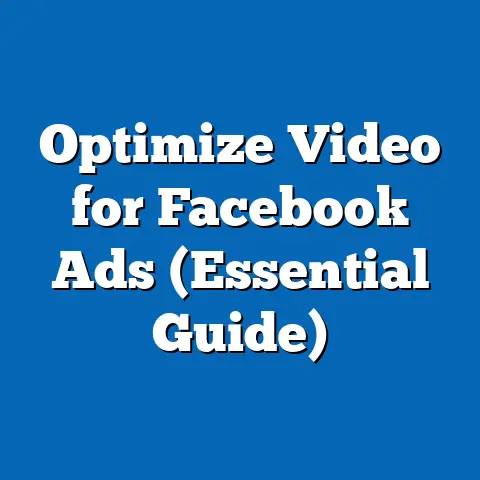Master Facebook Political Ads Verification (Expert Strategies)
In today’s hyper-connected world, Facebook stands as a colossal platform, a virtual town square where political discourse unfolds, opinions clash, and elections are often won or lost. As a digital marketing expert who has navigated the intricate landscape of Facebook advertising for years, I’ve witnessed firsthand the platform’s immense power in shaping political narratives and influencing voter behavior. However, with this power comes a great responsibility: the need for transparency, accountability, and strict adherence to Facebook’s evolving policies. That’s where the Facebook political ads verification process comes in.
Section 1: Understanding Facebook’s Political Ads Landscape
Before diving into the nitty-gritty of verification, it’s crucial to understand what Facebook considers a political ad and how their policies have evolved.
What Constitutes Political Ads on Facebook?
Facebook’s definition of political ads is broad, encompassing a wide range of content. Generally, it includes any ad that:
- Refers to candidates: Ads that explicitly mention a candidate running for public office.
- Discusses elections: Ads that promote or oppose a specific election outcome.
- Addresses political issues: Ads that focus on topics of national importance or public debate, such as climate change, healthcare, or immigration.
- Advocates for or against legislation: Ads that encourage viewers to support or oppose a particular bill or policy.
Examples:
- An ad endorsing a presidential candidate with their name and image.
- An ad urging people to vote in a local election.
- An ad advocating for stricter gun control laws.
- An ad opposing a proposed tax increase.
It’s important to note that even if your ad doesn’t explicitly mention a political party or candidate, it can still be classified as political if it touches on a sensitive political issue. This is where things can get tricky, and it’s always better to err on the side of caution and go through the verification process.
The Evolution of Political Advertising on Social Media
Political advertising on social media has undergone a dramatic transformation since its inception. In the early days, it was a wild west, with minimal regulation and oversight. However, following the 2016 US presidential election, which exposed the potential for misuse and manipulation, Facebook and other platforms began to crack down on political ads.
Facebook’s policies have evolved significantly over time, with increasing emphasis on transparency and accountability. They’ve introduced measures such as:
- Ad Library: A public database that allows users to see all political ads running on Facebook and Instagram, including who paid for them.
- Verification Requirements: A stringent process for verifying the identity and location of political advertisers.
- Policy Updates: Regular updates to their advertising policies to address emerging threats and challenges.
As someone who has been in the digital marketing trenches for years, I’ve had to constantly adapt to these changes. It’s a moving target, and what was acceptable last year might not be today. Staying informed and proactive is key.
The Importance of Verification and the Implications of Non-Compliance
Facebook’s verification process is designed to ensure that political advertisers are who they say they are and that they’re transparent about their funding sources. This helps to prevent foreign interference in elections, combat misinformation, and promote a more informed public discourse.
Non-compliance can have serious consequences, including:
- Ad Rejection: Your ads may be rejected or taken down if you’re not properly verified.
- Account Suspension: Your advertising account may be suspended or permanently banned.
- Legal Penalties: In some cases, you may face legal penalties for violating election laws.
I’ve seen many campaigns derailed by non-compliance issues. It’s not worth the risk. Investing the time and effort to get properly verified is a crucial step in ensuring your political advertising efforts are successful and sustainable.
Takeaway: Understanding the political ads landscape on Facebook and the importance of verification is the foundation for successful and compliant political advertising. Stay informed about policy updates and always err on the side of caution.
Section 2: The Verification Process Explained
Now, let’s dive into the heart of the matter: the Facebook political ads verification process. This section will provide a step-by-step breakdown of what you need to do to get verified.
Step-by-Step Breakdown of the Verification Process
The verification process typically involves the following steps:
- Accessing the Authorization Process: Navigate to the “Authorization” section within Ads Manager. This is where you’ll initiate the process of confirming your identity and advertising location.
- Confirming Your Identity: You’ll be prompted to provide a copy of a government-issued photo ID, such as a driver’s license or passport. Facebook uses this to verify your identity and ensure you are who you claim to be.
- Confirming Your Location: You’ll need to provide documentation that confirms your physical address. This could be a utility bill, bank statement, or other official document. Facebook will then send a postcard to that address with a unique code that you’ll need to enter online to complete the verification process.
- Disclosing Your Funding Sources: You’ll be required to disclose who is paying for your ads. This is a critical step in promoting transparency and preventing hidden agendas.
- Creating a “Paid for by” Disclaimer: This disclaimer will appear on all your political ads, clearly stating who is responsible for the ad. This is another key element in promoting transparency and accountability.
- Submitting Political Ad Disclaimers: Submitting disclaimers involves providing information about who is responsible for the content of your political ads. This step ensures that viewers can easily identify the source of the ad and understand who is behind the message.
- Waiting for Approval: Once you’ve completed all the steps, you’ll need to wait for Facebook to review your application. This can take a few days or even weeks, so it’s important to be patient.
I remember the first time I went through this process. It felt like navigating a bureaucratic maze. But with careful preparation and attention to detail, it can be done smoothly.
Types of Entities That Need to Be Verified
The verification requirements apply to a wide range of entities, including:
- Individuals: Anyone running political ads in their own name.
- Organizations: Political parties, advocacy groups, and other organizations running political ads.
- Political Action Committees (PACs): Organizations that raise and spend money to elect and defeat candidates.
Regardless of the type of entity you represent, you’ll need to go through the same verification process.
The Role of the Facebook Ads Manager
Make sure you’re familiar with the Ads Manager interface and how to navigate to the verification section. This will save you time and frustration in the long run.
Takeaway: The verification process is a multi-step process that requires careful attention to detail. Familiarize yourself with the requirements, gather your documentation, and use the Facebook Ads Manager to manage your application.
Section 3: Key Requirements for Successful Verification
While the verification process may seem straightforward, there are specific requirements that you must meet to be successful. Let’s take a closer look at these key requirements.
Identity Verification
Identity verification is a critical step in the process. You’ll need to submit a clear and legible copy of a government-issued photo ID, such as a driver’s license or passport.
Here are some tips for ensuring your ID is accepted:
- Make sure the photo is clear and in focus.
- Ensure all information is visible and legible.
- Don’t crop or alter the ID in any way.
I’ve seen applications rejected simply because the ID photo was blurry or the information was difficult to read. Don’t let this happen to you.
Physical Address Confirmation
Confirming your physical address is another essential requirement. Facebook needs to verify that you are located where you claim to be.
You can typically use a utility bill, bank statement, or other official document that shows your name and address.
Here are some things to keep in mind:
- The document must be recent (usually within the last 3 months).
- The name and address on the document must match the information you provided in your application.
- The document must be legible and in good condition.
Transparency in Disclosing Funding Sources and Affiliations
Transparency is paramount in political advertising. You must be upfront about who is paying for your ads and any relevant affiliations.
This means disclosing:
- The name of the individual or organization funding the ads.
- Any relevant affiliations or connections to political parties or candidates.
Facebook wants to ensure that voters know who is behind the ads they’re seeing. Hiding or misrepresenting your funding sources can lead to serious consequences.
Takeaway: Meeting the key requirements for identity verification, physical address confirmation, and transparency in disclosing funding sources is essential for successful verification. Pay close attention to the details and ensure you provide accurate and complete information.
Section 4: Common Challenges and How to Overcome Them
Even with careful preparation, you may encounter challenges during the verification process. Let’s explore some common pitfalls and how to overcome them.
Common Pitfalls and Challenges
- Documentation Issues: Providing incomplete, illegible, or outdated documentation.
- Identity Confusion: Discrepancies between the name on your ID and the information you provided in your application.
- Misunderstanding Facebook’s Policies: Failing to understand the specific requirements and guidelines for political advertising.
- Technical Glitches: Experiencing technical issues with the Facebook Ads Manager or the verification process.
- Delays in Approval: Waiting for an extended period for Facebook to review your application.
Expert Strategies for Overcoming These Challenges
- Double-Check Your Documentation: Before submitting your application, carefully review all your documentation to ensure it’s complete, legible, and up-to-date.
- Ensure Consistency: Make sure the information you provide in your application matches the information on your ID and other documents.
- Familiarize Yourself with Facebook’s Policies: Take the time to thoroughly review Facebook’s advertising policies and guidelines for political ads.
- Contact Facebook Support: If you encounter technical issues or have questions about the verification process, don’t hesitate to contact Facebook support.
- Be Patient: The verification process can take time. Be patient and persistent. Follow up with Facebook support if you haven’t heard back within a reasonable timeframe.
I once had a client whose application was rejected because of a minor discrepancy in their address. It turned out they had used “St.” instead of “Street” in their application. It was a small detail, but it caused a significant delay. The lesson learned: pay attention to every detail.
Takeaway: Be prepared for potential challenges during the verification process. By anticipating these issues and implementing the strategies outlined above, you can increase your chances of a successful outcome.
Section 5: Best Practices for Effective Political Ads
Once you’re verified, it’s time to focus on creating effective political ads that resonate with your audience while remaining compliant with Facebook’s policies.
Creating Compliance-Friendly Political Ads
- Avoid Misleading or Deceptive Content: Be truthful and accurate in your advertising. Don’t make false or unsubstantiated claims.
- Respect Intellectual Property Rights: Don’t use copyrighted material without permission.
- Avoid Hate Speech and Discrimination: Don’t target or discriminate against individuals or groups based on their race, ethnicity, religion, gender, sexual orientation, or other protected characteristics.
- Be Transparent About Your Message: Clearly state your position on the issues you’re addressing. Don’t try to hide or obfuscate your message.
Aligning Ad Content with Facebook’s Advertising Policies
It’s crucial to ensure that your ad content aligns with Facebook’s advertising policies. This means avoiding:
- Sensational or Provocative Content: Don’t use shocking or offensive images or language.
- Personal Attacks: Focus on the issues, not personal attacks against your opponents.
- Misinformation and Disinformation: Don’t spread false or misleading information.
The Role of Audience Targeting
Audience targeting is a powerful tool for maximizing ad effectiveness. However, it’s important to use it responsibly and ethically.
- Target Based on Relevant Interests and Demographics: Target your ads to people who are likely to be interested in your message.
- Avoid Discriminatory Targeting: Don’t target or exclude individuals or groups based on protected characteristics.
- Be Transparent About Your Targeting Criteria: Be upfront about who you’re targeting and why.
I’ve seen campaigns that used overly broad targeting and ended up wasting a lot of money on irrelevant impressions. On the other hand, I’ve seen campaigns that used highly targeted audiences and achieved incredible results. It’s all about finding the right balance.
Takeaway: Creating effective political ads requires a combination of creativity, strategic thinking, and a deep understanding of Facebook’s advertising policies. By following these best practices, you can create ads that resonate with your audience while remaining compliant with Facebook’s guidelines.
Section 6: Case Studies of Successful Political Ad Campaigns
To illustrate the principles discussed above, let’s examine a few case studies of political campaigns that successfully navigated the verification process and executed effective Facebook ad campaigns.
Case Study 1: The Grassroots Movement for Local Change
This campaign focused on promoting a local candidate running for city council. They started by thoroughly understanding Facebook’s political advertising policies and ensuring they met all the verification requirements. They then crafted a series of ads that highlighted the candidate’s commitment to local issues, such as improving schools and creating jobs.
Key Success Factors:
- Hyperlocal Targeting: They targeted their ads to residents within the city limits, ensuring their message reached the right audience.
- Authentic Messaging: They used authentic language and visuals that resonated with local voters.
- Community Engagement: They actively engaged with commenters on their ads, answering questions and addressing concerns.
Case Study 2: The National Advocacy Group for Environmental Protection
This campaign aimed to raise awareness about climate change and advocate for specific environmental policies. They went through the verification process and created a series of ads that featured compelling visuals and data-driven arguments.
Key Success Factors:
- Data-Driven Messaging: They used data and statistics to support their claims and make a compelling case for environmental protection.
- Strategic Partnerships: They partnered with other environmental organizations to amplify their message and reach a wider audience.
- Call to Action: They included a clear call to action in their ads, encouraging viewers to sign a petition or contact their elected officials.
Lessons Learned
These case studies demonstrate that successful political advertising on Facebook requires a combination of:
- Compliance: Adhering to Facebook’s advertising policies and verification requirements.
- Strategic Targeting: Reaching the right audience with the right message.
- Authentic Messaging: Creating ads that resonate with voters and build trust.
- Engagement: Interacting with viewers and addressing their concerns.
Takeaway: Studying successful political ad campaigns can provide valuable insights and inspiration for your own efforts. Pay attention to the strategies that worked well and adapt them to your own unique circumstances.
Conclusion
Mastering the Facebook political ads verification process is not just a matter of compliance; it’s a strategic imperative for any political campaign seeking to leverage the platform’s immense reach and influence. By understanding Facebook’s policies, navigating the verification process with diligence, and implementing best practices for effective, compliant advertising, you can unlock the power of political advertising on Facebook and achieve your campaign goals.
I encourage you to approach the verification process with a strategic mindset, viewing it as an opportunity to build trust and credibility with your audience. Remember that successful political advertising on Facebook requires both compliance and creativity. By combining these two elements, you can create campaigns that are not only effective but also ethical and responsible. Now go forth and make your voice heard!






